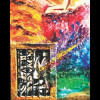‘Unwind Mind’: Exploring art as a pathway to mental wellness

Art has long been a medium for human expression, but its connection to mental well-being is often underappreciated. The "Unwind Mind" exhibition, hosted by the mental health organisation Psycure, is a refreshing take on this bond.
In celebration of World Mental Health Day, this two-week exhibition, running from October 19 to November 2 at the EMK Centre in Gulshan, brings together photography, digital art, and painting to highlight mental health awareness.

The exhibition features a selection from over 1,173 submitted entries, narrowing down to 40 artworks, each offering unique insights into the complex emotions tied to mental health. By providing a creative space for individuals to express their experiences, Psycure is not only amplifying voices often left unheard but also helping to forge connections between art, society, and mental well-being. The event offers a platform for art enthusiasts and creators to delve into mental health issues, breaking the stigma surrounding them.

Psycure, a pioneering mental health organisation in Bangladesh, has been advocating for mental health awareness since its inception. With a focus on counselling, psychotherapy, and mental health education, Psycure recognises that mental health issues remain largely misunderstood in society. Murad Ansary, the founder and CEO of Psycure, emphasises that the exhibition is an extension of their ongoing efforts to destigmatise mental health.

Art has always been a powerful vehicle for communication, transcending words and breaking down societal barriers. This exhibition seeks to leverage that power, using art to reach people who may otherwise struggle to articulate their mental health struggles. By turning personal emotions into visual expressions, the artists involved are helping to normalise the conversation around mental well-being in a society where these topics often remain taboo.

Walking through the exhibition, one is immediately struck by the diversity of mediums and perspectives on display. Each piece tells a story, whether through vivid colours or abstract forms, pulling viewers into the inner world of the artist. From striking depictions of isolation and despair to more hopeful portrayals of healing and resilience, the artworks encapsulate a wide range of emotions tied to mental health.

Photography, in particular, stands out as a medium that captures the rawness of mental health struggles. One particular photograph by Mahmudul Hasan Jayed stands out as a reminder of the playful spirit of childhood. Emotions and friendships are very important for mental health. The photograph of a group of children playing carefree amidst a field feels somewhat liberating and reminiscent of how simpler everything is when we are with our loved ones.

Digital art, meanwhile, offers a more abstract exploration of mental health. The fluidity of digital media allows for the representation of complex emotions that may be difficult to convey through more traditional forms. For example, "Isolate" by Bishara Ikhtii captures the emotional complexity of distancing oneself from others in times of mental turmoil. The piece features a girl with freshly cut hair, symbolising an attempt to redefine herself and move beyond her emotional struggles. In muted tones and sharp contrasts, the painting portrays the difficult balance between self-preservation and the consequences of shutting out those who care, challenging the intricate dynamics of emotional withdrawal and the weight of invisible connections.

"Safer on The Other Side" by Fahim Rezowan Rabid captures a haunting depiction of withdrawal and self-preservation. A lone figure, half-submerged in shadow, stands in the centre of the piece leaning against a doorway. The door seems to act as a barrier between two worlds—one of relative safety and the other filled with unsettling, hovering eyes. These disembodied eyes, with their glaring red outlines and harsh glares, surround the figure, symbolising judgement, societal pressure, or the invasive feeling of constantly being watched.

Painting, often considered the most intimate of the three mediums, provides a visceral connection to the artist's inner world. "The Eternal Cage of the Mind" by Eshan Debnath powerfully encapsulates the internal struggle of mental health, illustrating the heavy burden of fear, judgement, and entrapment. Central figures appear bound by chains, their bodies contorted in anguish as they attempt to break free from the darkness. A staircase leading nowhere symbolises unattainable goals, and the noose hanging above hints at the harrowing thoughts of escape through suicide. Surrounding them, ominous figures and unseen eyes intensify the sense of being watched, reflecting the suffocating pressure of societal judgement. The painting highlights the devastating consequences of caging the heart, relying solely on the mind, and succumbing to the fear of external perceptions.

Historically, artists have often drawn from their own struggles with mental health to create some of the most powerful and enduring works of art. Vincent van Gogh, Frida Kahlo, and Edvard Munch are just a few examples of artists whose work was deeply influenced by their mental health experiences. In recent years, the therapeutic benefits of art have also gained recognition within the mental health community. Art therapy has become a widely used practice in clinical settings, helping individuals process trauma, express difficult emotions, and improve self-esteem. Psycure's exhibition brings this concept to the forefront, demonstrating that art can be both a reflection of mental health struggles and a tool for healing.

This initiative highlights the importance of awareness, dialogue, and support systems in combating the mental health crisis. By bringing together art, mental health professionals, and the public, the exhibition creates a space for reflection and understanding.

As the exhibition runs until November 2, it offers visitors a chance to engage with mental health in a way that is both personal and communal. The artworks on display serve as reminders that mental health is not just an individual issue but a societal one. Whether through the lens of a camera, the stroke of a brush, or the click of a mouse, these artists have contributed to a larger conversation—one that Psycure hopes will continue long after the exhibition closes.

 For all latest news, follow The Daily Star's Google News channel.
For all latest news, follow The Daily Star's Google News channel. 








Comments